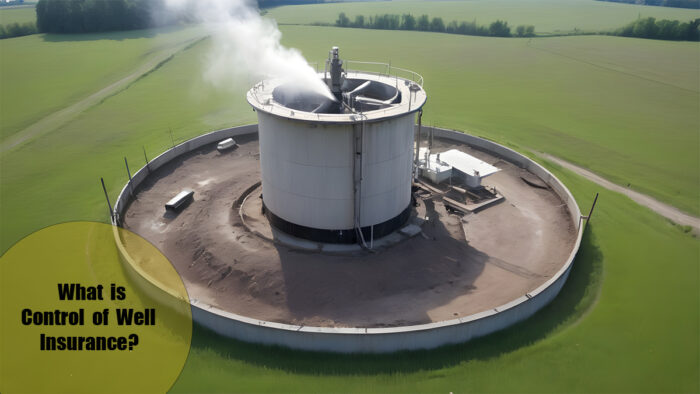In the challenging field of oil and gas drilling, companies frequently confront the peril of good blowouts, a situation where natural forces fiercely clash with human engineering. These events, marked by the uncontrollable discharge of gas or oil, present not only a hazard to the environment but also pose substantial financial and operational risks. To safeguard against the repercussions of such incidents, the oil and gas sector turns to control of well insurance.

This specialized insurance coverage plays a pivotal role in managing the financial aftermath and facilitating the rapid resolution of these emergencies.
It is a critical element in the risk management strategies of these operations, ensuring coverage for the hefty expenses involved in regaining well control, addressing environmental repercussions, and potentially restoring or redrilling wells.
What is Control of Well Insurance?
Control of Well Insurance is a specialized insurance policy designed for the oil and gas industry. It offers financial protection to operators against the risks associated with the uncontrolled release of natural gas, oil, or other drilling fluids from a well. Events that can also lead to significant operational, environmental, and financial damages are covered and taken care of with just this single policy.
How Does It Work?
When a covered incident occurs, such as a blowout or well collapse, the insurance policy kicks in to cover the costs associated with regaining control of the well, cleaning up pollution, and any necessary restoration or redrilling efforts. The insurance provider assesses the claim and disburses funds based on the terms of the policy to cover the insured losses.
The insurance covers expenses related to:
- Well restoration and re-drilling efforts.
- Reestablishing control over the well.
- Environmental cleanup and pollution mitigation following a spill.
What Does Control of Well Insurance Cover?
Here are scenarios and events where you will receive coverage after filing a claim under your control of well insurance policy:
- Regaining control of the well.
- Cleaning up pollution and environmental restoration.
- Redrilling or restoring the well.
- Evacuation expenses.
- Seepage and pollution cleanup.
- Legal defense costs for covered claims.
What Does It Not Cover?
Just like other types of insurance policies, control of well insurance has exclusions and events that it will not offer coverage for. They include:
- Normal operational expenses.
- Damage from war or governmental actions.
- Willful misconduct or negligence.
- Pre-existing conditions known to the insured.
- Wear and tear or maintenance issues.
Who Needs a Policy?
Any entity involved in the drilling, maintenance, or operation of oil and gas wells needs this policy. This includes oil and gas companies, drilling contractors, and lease operators who face significant risks from potential well control events.
How Much Does Control of Well Insurance Cost?
The cost of control of well insurance differs based on the size and scope of the operation and the location of the wells (onshore or offshore). Additionally, the coverage limits of the policy and the depth and complexity of the drilling activities affect the cost of this quote. Premiums can fall between a few thousand and several hundred thousand dollars per year.
How to Get Control of Well Insurance
Obtaining control of well insurance is a structured approach to making sure you get coverage that meets the specific needs of your oil and gas operations. Here is a helpful guide on how to secure this type of insurance:
• Assess Your Needs
Start by evaluating the specific risks associated with your drilling operations. Consider the location, depth, and type of wells you operate. These factors can significantly influence the level of risk and type of coverage you need.
• Research insurance providers
Look for insurance companies with experience in the oil and gas industry, especially those that specialize in control of well insurance. Experienced insurers can offer insights and coverage options tailored to the unique risks of oil and gas operations.
• Gather necessary information
Prepare detailed information about your operations. This includes the number of wells, their locations, drilling depths, and any previous incidents or claims. Insurers will require this information to accurately assess your risk profile and determine your premium.
• Request quotes
Contact several insurers to request quotes. Be prepared to provide comprehensive details about your operations to ensure the quotes you receive are accurate and reflective of your specific needs.
• Compare coverage and premiums
Carefully compare the coverage options, limits, deductibles, exclusions, and premiums offered by different insurers. Look beyond the premium cost to understand the scope of coverage and how it aligns with your risk assessment.
• Consult with experts
Consider consulting with an insurance broker or agent who specializes in the oil and gas sector. These professionals can offer valuable advice, help you navigate the insurance market, and negotiate terms on your behalf.
• Review the policy
Before finalizing the insurance, thoroughly review the policy documents. Ensure you understand the coverage provided, as well as any exclusions or conditions that apply. Ask for clarifications if any part of the policy is unclear.
• Finalize and purchase
If you are okay and agree with the coverage and terms, finalize the agreement and purchase the policy. Ensure you keep all documentation in a safe place and understand the process for filing a claim, should the need arise.
By following these steps, you can secure control of well insurance that provides robust protection against the unique risks faced by your oil and gas operations.



